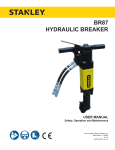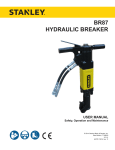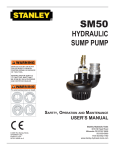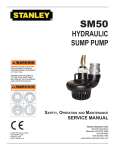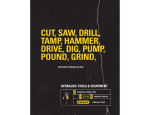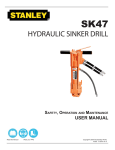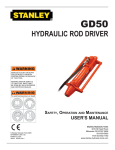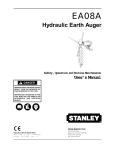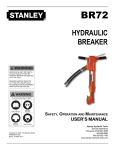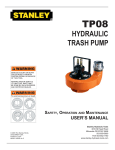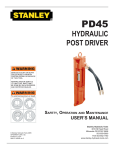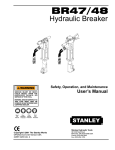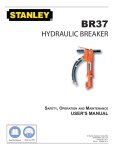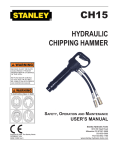Download User Manual - Truck Utilities Inc
Transcript
BR87 HYDRAULIC BREAKER WARNING WARNING To avoid serious injury or death SAFETY, OPERATION AND MAINTENANCE USER'S MANUAL © Stanley Hydraulic Tools 2006 OPS/MAINT USA / CE Printed in U.S.A. 65778 1/2006 ver 3 Stanley Hydraulic Tools 3810 SE Naef Road Milwaukie OR 97267-5698 503-659-5660 FAX 503-652-1780 www.stanley-hydraulic-tools.com TABLE OF CONTENTS CERTIFICATE OF CONFORMITY ........................................................................................................................................4 SAFETY SYMBOLS ..............................................................................................................................................................5 SAFETY PRECAUTIONS......................................................................................................................................................6 TOOL STICKERS & TAGS ....................................................................................................................................................7 HYDRAULIC HOSE REQUIREMENTS.................................................................................................................................8 HTMA REQUIREMENTS.......................................................................................................................................................9 OPERATION........................................................................................................................................................................10 PRE-OPERATION PROCEDURES.....................................................................................................................................10 CHECK POWER SOURCE .................................................................................................................................................10 INSTALL TOOL BIT .............................................................................................................................................................10 CONNECT HOSES .............................................................................................................................................................10 OPERATION PROCEDURES .............................................................................................................................................10 COLD WEATHER OPERATION ..........................................................................................................................................10 EQUIPMENT PROTECTION & CARE ................................................................................................................................ 11 TROUBLESHOOTING ........................................................................................................................................................12 CHARGING THE ACCUMULATOR .....................................................................................................................................13 ACCUMULATOR TESTING PROCEDURE ........................................................................................................................13 ACCUMULATOR CHARGING .............................................................................................................................................13 GENERAL SERVICE NOTES .............................................................................................................................................13 UNDERWATER MODEL PREVENTATIVE MAINTENANCE ..............................................................................................14 SPECIFICATIONS ...............................................................................................................................................................15 ACCESSORIES ..................................................................................................................................................................15 SERVICE TOOLS ................................................................................................................................................................15 BR87 PARTS ILLUSTRATION ............................................................................................................................................16 BR87 PARTS LIST ..............................................................................................................................................................18 WARRANTY ........................................................................................................................................................................19 SERVICING THE STANLEY HYDRAULIC breaker. This manual contains safety, operation, and routine maintenance instructions. Stanley Hydraulic Tools recommends that servicing of hydraulic tools, other than routine maintenance, must be performed by an authorized and certified dealer. Please read the following warning. WARNING SERIOUS INJURY OR DEATH COULD RESULT FROM THE IMPROPER REPAIR OR SERVICE OF THIS TOOL. REPAIRS AND / OR SERVICE TO THIS TOOL MUST ONLY BE DONE BY AN AUTHORIZED AND CERTIFIED DEALER. For the nearest authorized and certified dealer, call Stanley Hydraulic Tools at the number listed on the back of this manual and ask for a Customer Service Representative. 3 CERTIFICATE OF CONFORMITY CERTIFICATE OF CONFORMITY Hydraulic Tools ______________________________________________________________________ I, the undersigned: Winterling, David Surname and First names Hereby certify that the construction plant or equipment specified hereunder: 1. Manufacturer: Stanley Hydraulic Tools, 3810 Naef Road, Milwaukie, Oregon USA 2. Representative in the Union: Stanley Svenska AB, Box 9054, 400 92 Göteborg, SWEDEN 3. Category: Hydraulic Hand Held Concrete Breaker 4. Make: Stanley Hydraulic Tools 5. Type: BR8713201 6. Type serial number of equipment: ALL 7. Year of manufacture: Beginning 2002 Has been manufactured in conformity with the provisions of the Machinery Directive 98/37/EC Harmonized standard applied: EN 792-4 We also declare that it meets the specification of Noise Directive 2000/14/EC, measured in accordance to the Conformity Evaluation Method set out in Annex VI para. 5 and evaluated during production as in Annex VI para. 6, 2nd procedure. 8. Noise related value: 38 kg 9. Measured sound power on equipment representative of this type: 110 LwA 10. Guaranteed sound power level for this equipment: 111 LwA 11. Notified body for EC directive 2000/14/EC: 0404 SMP Svensk Maskinprovning AB Fyrisborgsgatan 3 754 50 Uppsala, SWEDEN 12. Special Provisions: None Issued at Stanley Hydraulic Tools, Milwaukie, Oregon USA Date: 8/21/02 Signature Position: Engineering Manager P/N 52575 Rev.2, 1/17/06 4 SAFETY SYMBOLS Safety symbols and signal words, as shown below, are used to emphasize all operator, maintenance and repair actions which, if not strictly followed, could result in a life-threatening situation, bodily injury or damage to equipment. This is the safety alert symbol. It is used to alert you to potential personal injury hazards. Obey all safety messages that follow this symbol to avoid possible injury or death. WARNING This safety alert and signal word indicate an imminently hazardous situation which, if not avoided, will result in death or serious injury. WARNING This safety alert and signal word indicate a potentially hazardous situation which, if not avoided, could result in death or serious injury. CAUTION This safety alert and signal word indicate a potentially hazardous situation which, if not avoided, may result in minor or moderate injury. CAUTION This signal word indicates a potentially hazardous situation which, if not avoided, may result in property damage. NOTICE This signal word indicates a situation which, if not avoided, will result in damage to the equipment. IMPORTANT This signal word indicates a situation which, if not avoided, may result in damage to the equipment. Always observe safety symbols. They are included for your safety and for the protection of the tool. LOCAL SAFETY REGULATIONS Enter any local safety regulations here. Keep these instructions in an area accessible to the operator and maintenance personnel. 5 SAFETY PRECAUTIONS WARNING To avoid serious injury or death Tool operators and maintenance personnel must always comply with the safety precautions given in this manual and on the stickers and tags attached to the tool and hose. These safety precautions are given for your safety. Review them carefully before operating the tool and before performing general maintenance or repairs. Supervising personnel should develop additional precautions relating to the specific work area and local safety regulations. If so, place the added precautions in the space provided in this manual. The BR87 Hydraulic Breaker will provide safe and dependable service if operated in accordance with the instructions given in this manual. Read and understand this manual and any stickers and tags attached to the tool and hoses before operation. Failure to do so could result in personal injury or equipment damage. • Operator must start in a work area without bystanders. The operator must be familiar with all prohibited work areas such as excessive slopes and dangerous terrain conditions. • Establish a training program for all operators to ensure safe operation. • Do not operate the tool unless thoroughly trained or under the supervision of an instructor. • Always wear safety equipment such as goggles, ear, head protection, and safety shoes at all times when operating the tool. • Do not inspect or clean the tool while the hydraulic power source is connected. Accidental engagement of the tool can cause serious injury. • Supply hoses must have a minimum working pressure rating of 2500 psi/175 bar. • Be sure all hose connections are tight. • The hydraulic circuit control valve must be in the “OFF” position when coupling or uncoupling the tool. Wipe all couplers clean before connecting. Use only lint-free cloths. Failure to do so may result in damage to the quick couplers and cause overheating of the hydraulic system. • Do not operate the tool at oil temperatures above 140°F/60°C. Operation at higher oil temperatures can cause operator discomfort and may damage the tool. • Do not operate a damaged, improperly adjusted, or incompletely assembled tool. • Do not weld, cut with an acetylene torch, or hardface the tool bit. • To avoid personal injury or equipment damage, all tool repair, maintenance and service must only be performed by authorized and properly trained personnel. • Do not exceed the rated limits of the tool or use the tool for applications beyond its design capacity. • Always keep critical tool markings, such as lables and warning stickers legible. • Always replace parts with replacement parts recommended by Stanley Hydraulic Tools. • Check fastener tightness often and before each use daily. • Never operate the tool if you cannot be sure that underground utilities are not present. • Do not wear loose fitting clothing when operating the tool. 6 TOOL STICKERS & TAGS WARNING To avoid serious injury or death 11207 Circuit Type C Decal 28409 Composite Decal 11208 Hex Shank Decal Lwa 111 28322 CE Decal 10180 Caution Decal 66656 Sound Level Decal Stanley Hydraulic tools Division of the Stanley Works 3810 SE Naef Road Milwaukie, OR 97267 28376 Stanley Decal 28381 BR87 Name Tag (Models BR8713201 & BR8717201 Only) D A N G E R 1. FAILURE TO USE HYDRAULIC HOSE LABELED AND CERTIFIED AS NON-CONDUCTIVE WHEN USING HYDRAULIC TOOLS ON OR NEAR ELECTRICAL LINES MAY RESULT IN DEATH OR SERIOUS INJURY. 07892 BR87 Name Decal BEFORE USING HOSE LABELED AND CERTIFIED AS NONCONDUCTIVE ON OR NEAR ELECTRIC LINES BE SURE THE HOSE IS MAINTAINED AS NON-CONDUCTIVE. THE HOSE SHOULD BE REGULARLY TESTED FOR ELECTRIC CURRENT LEAKAGE IN ACCORDANCE WITH YOUR SAFETY DEPARTMENT INSTRUCTIONS. 2. A HYDRAULIC LEAK OR BURST MAY CAUSE OIL INJECTION INTO THE BODY OR CAUSE OTHER SEVERE PERSONAL INJURY. A The safety tag (p/n 15875) at right is attached to the tool when shipped from the factory. Read and understand the safety instructions listed on this tag before removal. We suggest you retain this tag and attach it to the tool when not in use. DO NOT EXCEED SPECIFIED FLOW AND PRESSURE FOR THIS TOOL. EXCESS FLOW OR PRESSURE MAY CAUSE A LEAK OR BURST. B DO NOT EXCEED RATED WORKING PRESSURE OF HYDRAU LIC HOSE USED WITH THIS TOOL. EXCESS PRESSURE MAY CAUSE A LEAK OR BURST. C CHECK TOOL HOSE COUPLERS AND CONNECTORS DAILY FOR LEAKS. DO NOT FEEL FOR LEAKS WITH YOUR D A N G E R D DO NOT LIFT OR CARRY TOOL BY THE HOSES. DO NOT ABUSE HOSE. DO NOT USE KINKED, TORN OR DAMAGED HOSE. 3. MAKE SURE HYDRAULIC HOSES ARE PROPERLY CONNECTED TO THE TOOL BEFORE PRESSURING SYSTEM. SYSTEM PRESSURE HOSE MUST ALWAYS BE CONNECTED TO TOOL “IN” PORT. SYSTEM RETURN HOSE MUST ALWAYS BE CONNECTED TO TOOL “OUT” PORT. REVERSING CONNECTIONS MAY CAUSE REVERSE TOOL OPERATION WHICH CAN RESULT IN SEVERE PERSONAL INJURY. 4. DO NOT CONNECT OPEN-CENTER TOOLS TO CLOSED-CENTER HYDRAULIC SYSTEMS. THIS MAY RESULT IN LOSS OF OTHER HYDRAULIC FUNCTIONS POWERED BY THE SAME SYSTEM AND/OR SEVERE PERSONAL INJURY. 5. BYSTANDERS MAY BE INJURED IN YOUR WORK AREA. KEEP BYSTANDERS CLEAR OF YOUR WORK AREA. 6. WEAR HEARING, EYE, FOOT, HAND AND HEAD PROTECTION. 7. TO AVOID PERSONAL INJURY OR EQUIPMENT DAMAGE, ALL TOOL REPAIR MAINTENANCE AND SERVICE MUST ONLY BE PERFORMED BY AUTHORIZED AND PROPERLY TRAINED PERSONNEL. IMPORTANT IMPORTANT READ OPERATION MANUAL AND SAFETY INSTRUCTIONS FOR THIS TOOL BEFORE USING IT. READ OPERATION MANUAL AND SAFETY INSTRUCTIONS FOR THIS TOOL BEFORE USING IT. USE ONLY PARTS AND REPAIR PROCEDURES APPROVED BY STANLEY AND DESCRIBED IN THE OPERATION MANUAL. USE ONLY PARTS AND REPAIR PROCEDURES APPROVED BY STANLEY AND DESCRIBED IN THE OPERATION MANUAL. TAG TO BE REMOVED ONLY BY TOOL OPERATOR. TAG TO BE REMOVED ONLY BY TOOL OPERATOR. SEE OTHER SIDE SEE OTHER SIDE SAFETY TAG P/N 15875 7 (shown smaller then actual size) HYDRAULIC HOSE REQUIREMENTS HOSE TYPES Hydraulic hose types authorized for use with Stanley Hydraulic Tools are as follows: Certified non-conductive Wire-braided (conductive) Fabric-braided (not certified or labeled non-conductive) Hose listed above is the only hose authorized for use near electrical conductors. Hoses and listed above are conductive and must never be used near electrical conductors. HOSE SAFETY TAGS To help ensure your safety, the following DANGER tags are attached to all hose purchased from Stanley Hydraulic Tools. DO NOT REMOVE THESE TAGS. If the information on a tag is illegible because of wear or damage, replace the tag immediately. A new tag may be obtained from your Stanley Distributor. D A N G E R D A N G E R 1 FAILURE TO USE HYDRAULIC HOSE LABELED AND CERTIFIED AS NON-CONDUCTIVE WHEN USING HYDRAULIC TOOLS ON OR NEAR ELECTRIC LINES MAYRESULT IN DEATH OR SERIOUS INJURY. FOR PROPER AND SAFE OPERATION MAKE SURE THAT YOU HAVE BEEN PROPERLY TRAINED IN CORRECT PROCEDURES REQUIRED FOR WORK ON OR AROUND ELECTRIC LINES. 3. DO NOT EXCEED HOSE WORKING PRESSURE OR ABUSE HOSE. IMPROPER USE OR HANDLING OF HOSE COULD RESULT IN BURST OR OTHER HOSE FAILURE. KEEP HOSE AS FAR AWAY AS POSSIBLE FROM BODY AND DO NOT PERMIT DIRECT CONTACT DURING USE. CONTACT AT THE BURST CAN CAUSE BODILY INJECTION AND SEVERE PERSONAL INJURY. 4. HANDLE AND ROUTE HOSE CAREFULLY TO AVOID KINKING, ABRASION, CUTTING, OR CONTACT WITH HIGH TEMPERATURE SURFACES. DO NOT USE IF KINKED. DO NOT USE HOSE TO PULL OR LIFT TOOLS, POWER UNITS, ETC. 2. BEFORE USING HYDRAULIC HOSE LABELED AND CERTIFIED AS NON-CONDUCTIVE ON OR NEAR ELECTRIC LINES. WIPE THE ENTIRE LENGTH OF THE HOSE AND FITTING WITH A CLEAN DRY ABSORBENT CLOTH TO REMOVE DIRT AND MOSISTURE AND TEST HOSE FOR MAXIMUM ALLOWABLE CURRENT LEAKAGE IN ACCORDANCE WITH SAFETY DEPARTMENT INSTRUCTIONS. 5. CHECK ENTIRE HOSE FOR CUTS CRACKS LEAKS ABRASIONS, BULGES, OR DAMAGE TO COUPLINGS IF ANY OF THESE CONDITIONS EXIST, REPLACE THE HOSE IMMEDIATELY. NEVER USE TAPE OR ANY DEVICE TO ATTEMPT TO MEND THE HOSE. 6. AFTER EACH USE STORE IN A CLEAN DRY AREA. SIDE 1 3 DO NOT REMOVE THIS TAG DO NOT REMOVE THIS TAG THE TAG SHOWN BELOW IS ATTACHED TO “CERTIFIED NON-CONDUCTIVE” HOSE SIDE 2 (shown smaller than actual size) D A N G E R D A N G E R 1 DO NOT USE THIS HYDRAULIC HOSE ON OR NEAR ELECTRIC LINES. THIS HOSE IS NOT LABELED OR CERTIFIED AS NON-CONDUCTIVE. USING THIS HOSE ON OR NEAR ELECTRICAL LINES MAY RESULT IN DEATH OR SERIOUS INJURY. 5. CHECK ENTIRE HOSE FOR CUTS CRACKS LEAKS ABRASIONS, BULGES, OR DAMAGE TO COUPLINGS IF ANY OF THESE CONDITIONS EXIST, REPLACE THE HOSE IMMEDIATELY. NEVER USE TAPE OR ANY DEVICE TO ATTEMPT TO MEND THE HOSE. 2. FOR PROPER AND SAFE OPERATION MAKE SURE THAT YOU HAVE BEEN PROPERLY TRAINED IN CORRECT PROCEDURES REQUIRED FOR WORK ON OR AROUND ELECTRIC LINES. 6. AFTER EACH USE STORE IN A CLEAN DRY AREA. 3. DO NOT EXCEED HOSE WORKING PRESSURE OR ABUSE HOSE. IMPROPER USE OR HANDLING OF HOSE COULD RESULT IN BURST OR OTHER HOSE FAILURE. KEEP HOSE AS FAR AWAY AS POSSIBLE FROM BODY AND DO NOT PERMIT DIRECT CONTACT DURING USE. CONTACT AT THE BURST CAN CAUSE BODILY INJECTION AND SEVERE PERSONAL INJURY. 4. HANDLE AND ROUTE HOSE CAREFULLY TO AVOID KINKING, CUTTING, OR CONTACT WITH HIGH TEMPERATURE SURFACES. DO NOT USE IF KINKED. DO NOT USE HOSE TO PULL OR LIFT TOOLS, POWER UNITS, ETC. DO NOT REMOVE THIS TAG DO NOT REMOVE THIS TAG THE TAG SHOWN BELOW IS ATTACHED TO “CONDUCTIVE” HOSE. SEE OTHER SIDE SIDE 1 SIDE 2 (shown smaller than actual size) HOSE PRESSURE RATING The rated working pressure of the hydraulic hose must be equal to or higher than the relief valve setting on the hydraulic system. 8 HTMA REQUIREMENTS TOOL CATEGORY HYDRAULIC SYSTEM REQUIREMENTS FLOW RATE TYPE 1 TYPE II 7-9 gpm (26-34 lpm) 2000 psi (138 bar) TYPE III TOOL OPERATING PRESSURE (at the power supply outlet) 4-6 gpm (15-23 lpm) 2000 psi (138 bar) SYSTEM RELIEF VALVE SETTING (at the power supply outlet) 2100-2250 psi 2100-2250 psi 2100-2250 psi 2200-2300 psi (145-155 bar) (145-155 bar) (145-155 bar) (152-159 bar) MAXIMUM BACK PRESSURE (at tool end of the return hose) 250 psi (17 bar) Measured at a max. fluid viscosity of: (at min. operating temperature) 400 ssu* 400 ssu* 400 ssu* 400 ssu* (82 centistokes) (82 centistokes) (82 centistokes) (82 centistokes) TEMPERATURE Sufficient heat rejection capacity to limit max. fluid temperature to: (at max. expected ambient temperature) 140° F (60° C) 140° F (60° C) 140° F (60° C) 140° F (60° C) Min. cooling capacity at a temperature difference of between ambient and fluid temps 3 hp (2.24 kW) 40° F (22° C) 5 hp (3.73 kW) 40° F (22° C) 7 hp (4.47 kW) 40° F (22° C) 6 hp (5.22 kW) 40° F (22° C) 250 psi (17 bar) 11-13 gpm (42-49 lpm) 2000 psi (138 bar) TYPE RR 250 psi (17 bar) 9-10.5 gpm (34-40 lpm) 2000 psi (138 bar) 250 psi (17 bar) NOTE: Do not operate the tool at oil temperatures above 140° F (60° C). Operation at higher temperatures can cause operator discomfort at the tool. FILTER 25 microns Min. full-flow filtration 30 gpm Sized for flow of at least: (114 lpm) (For cold temp. startup and max. dirt-holding capacity) 25 microns 30 gpm (114 lpm) HYDRAULIC FLUID Petroleum based (premium grade, anti-wear, non-conductive) VISCOSITY (at min. and max. operating temps) 100-400 ssu* 100-400 ssu* (20-82 centistokes) 100-400 ssu* 25 microns 30 gpm (114 lpm) 25 microns 30 gpm (114 lpm) 100-400 ssu* NOTE: When choosing hydraulic fluid, the expected oil temperature extremes that will be experienced in service determine the most suitable temperature viscosity characteristics. Hydraulic fluids with a viscosity index over 140 will meet the requirements over a wide range of operating temperatures. *SSU = Saybolt Seconds Universal NOTE: These are general hydraulic system requirements. See tool Specification page for tool specific requirements. 9 OPERATION The recommended hose size is .500 inch/12 mm I.D. up to 50 ft/15 m long and .625 inch/16 mm I.D. minimum up to 100 ft/30 m. 3. Place the bit firmly on the surface to be broken. 4. Squeeze the trigger to start the breaker. Adequate down pressure is very important. When the tool bit breaks through the obstruction or becomes bound, release the trigger and reposition the tool bit. PRE-OPERATION PROCEDURES CHECK POWER SOURCE NOTE: Partially depressing the trigger allows the tool to run at slow speed. Slow-speed operation permits easier starting of the tool bit into the work surface. 1. Using a calibrated flowmeter and pressure gauge, check that the hydraulic power source develops a flow of 7-9 gpm/26-34 lpm at 1500-2000 psi/105-140 bar. 2. Make certain the hydraulic power source is equipped with a relief valve set to open at 2100-2250 psi/145-155 bar maximum. INSTALL TOOL BIT 5. To start, break an opening (hole) in the center of the surface. After making a hole, break portions of the material into the original opening. For best productivity, the breaking should be done around the original hole. The size of the broken material will vary with the strength and thickness of the base material and the amount of any reinforcement wire or rebar. 1. Rotate the latch on the breaker foot downward (pointing away from the tool). 2. Insert the tool bit into the foot and pull the latch up to lock the tool bit in place. Harder material or more reinforcing wire or rebar will require taking smaller bites. To determine the most effective bite, start with 2 in. / 50 mm or smaller bites. CONNECT HOSES 1. Wipe all hose couplers with a clean, lint-free cloth before making connections. Bites can then be gradually increased until the broken piece becomes too large, requiring increased time to break off the piece. 2. Connect the hoses from the hydraulic power source to the tool fittings or quick disconnects. It is a good practice to connect return hoses first and disconnect them last to minimize or avoid trapped pressure within the tool. Sticking of the tool bit occurs when too large a bite is being taken and the tool bit hammers into the material without the material fracturing. This causes the tool bit to become trapped in the surrounding material. 3. Observe flow indicators stamped on hose couplers to ensure that fluid flow is in the proper direction. The female coupler on the tool hose is the inlet coupler. 6. The underwater model requires preventative maintenance after each day’s use underwater and prior to being placed in storage. See the General Service Notes section in this manual for this maintenance procedure. 4. Move the hydraulic circuit control valve to the ON position to operate the tool. COLD WEATHER OPERATION NOTE: If uncoupled hoses are left in the sun, pressure increase within the hoses may make them difficult to connect. When possible, connect the free ends of the hoses together. If the breaker is to be used during cold weather, preheat the hydraulic fluid at low engine speed. When using the normally recommended fluid, fluid temperature should be at or above 50° F/10° C (400 ssu/82 centistokes) before use. Damage to the hydraulic system or breaker can result from use with fluid that is too viscous or thick. OPERATION PROCEDURES 1. Observe all safety precautions. 2. Install the appropriate tool bit for the job. 10 EQUIPMENT PROTECTION & CARE NOTICE In addition to the Safety Precautions found in this manual, observe the following for equipment protection and care. • Make sure all couplers are wiped clean before connection. • The hydraulic circuit control valve must be in the “OFF” position when coupling or uncoupling hydraulic tools. Failure to do so may result in damage to the quick couples and cause overheating of the hydraulic system. • Always store the tool in a clean dry space, safe from damage or pilferage. • Make sure the circuit PRESSURE hose (with male quick disconnect) is connected to the “IN” port. The circuit RETURN hose (with female quick disconnect) is connected to the opposite port. Do not reverse circuit flow. This can cause damage to internal seals. • Always replace hoses, couplings and other parts with replacement parts recommended by Stanley Hydraulic Tools. Supply hoses must have a minimum working pressure rating of 2500 psi/172 bar. • Do not exceed the rated flow (see Specifications in this manual for correct flow rate and model number). Rapid failure of the internal seals may result. • Always keep critical tool markings, such as warning stickers and tags legible. • Do not force a small breaker to do the job of a large breaker. • Keep tool bit sharp for maximum breaker performance. Make sure that tool bits are not chipped or rounded on the striking end. • Never operate a breaker without a tool bit or without holding it against the work surface. This puts excessive strain on the breaker foot. • Tool repair should be performed by experienced personnel only. • Make certain that the recommended relief valves are installed in the pressure side of the system. • Do not use the tool for applications for which it was not intended. 11 TROUBLESHOOTING PROBLEM Tool does not run. Tool does not hit effectively. Tool operates slow. Tool gets hot. CAUSE REMEDY Power unit not functioning. Check power unit for proper flow and pressure (7-9 gpm/26-34 lpm, 1500-2000 psi/105-140 bar. Couplers or hoses blocked. Remove restriction. Pressure and return line hoses reversed at ports. Be sure hoses are connected to their proper ports. Mechanical failure of piston or automatic valve. Disassemble breaker and inpsect for damaged parts. Power unit not functioning. Check power unit for proper flow and pressure (7-9 gpm/26-34 lpm, 1500-2000 psi/105-140 bar. Couplers or hoses blocked. Remove restriction. Low accumulator charge (pressure hose will pulse more than normal). Recharge accumulator. Replace diaphragm if charge loss continues. Fluid too hot (above 140°F/60°C). Provide cooler to maintain proper fluid temperature (130°F/55°C). The collar support is not sliding freely in the foot bore. Remove, clean and replace as required. Make sure hex bushing is in the proper location. Low gpm supply from power unit. Check power unit for proper flow (7-9 gpm/ 26-34 lpm). High backpressure. Check hydraulic system for excessive backpressure (over 250 psi/17 bar). Couplers or hoses blocked. Remove restriction. Orifice plug blocked. Remove restriction. Fluid too hot (above 140°F/60°C) or too cold (below 60°F/16°C). Check power unit for proper fluid temperature. Bypass cooler to warm the fluid or provide cooler to maintain proper temperature. The collar support is not sliding freely in the foot bore. Remove, clean and replace as required. Make sure hex bushing is in the proper location. Relief valve set too low. Adjust relief valve to 2100-2250 psi/145-155 bar. Hot fluid going through tool. Check power unit. Be sure flow rate is not too high causing part of the fluid to go through the relief valve. Provide cooler to maintain proper fluid temperature (140°F/60°C max). Check the relief valve setting. Eliminate flow control devices. Fluid leakage on tool bit. Lower piston seal failure. Replace seal. Fluid leakage through charge valve cap. Upper piston seal failure or accumulator o-ring failure or accumulator charge loss or failure. Replace seals, recharge or replace accumulator diaphragm. Fluid leakage around trigger. Valve spool seal failure. Replace seals. 12 CHARGING THE ACCUMULATOR ACCUMULATOR TESTING PROCEDURE 3. Adjust the regulator to the charging pressure of 800 psi/55 bar. To check or charge the accumulator the following equipment is required: NOTE: It may be necessary to set the gauge at 850-900 psi/59-62 bar to overcome any pressure drop through the charging system. 31254 Charge Kit: which includes the following. • Accumulator Tester (Part Number 02835). • Charging Assembly (Part Number 15304). (p/n 15304 includes a liquid filled gauge with snub valve, hose and fittings.) 4. Open the valve on the charging assembly hose. 5. When the accumulator is fully charged close the valve on the charging assembly hose and remove the charging assembly chuck from the accumulator tester or tool charging valve. • NITROGEN bottle with an 1000 psi/70 bar minimum charge. (Not included in 31254 Charge Kit.) 1. Remove the valve cap assembly from the breaker. 6. If the accumulator tester has been used, be sure to turn the gauge-end fully counterclockwise before removing the tester from the charging valve of the tool. 2. Remove the protective cap and loosen the 5/8-inch hex locking nut on the tool charging valve 1-1/2 turns. 7. Tighten the 5/8-inch hex locking nut on the tool charging valve and replace the protective cap. 3. Holding the chuck end of Accumulator Tester (Part Number 02835) turn the gauge fully counterclockwise to ensure that the stem inside the chuck is completely retracted. 8. Replace the valve cap assembly. 4. Thread the tester onto the accumulator charging valve. Do not advance the gauge-end into the chuck-end. Turn as a unit. Seat the chuck on the accumulator charging valve and hand tighten only. GENERAL SERVICE NOTES 1. If the breaker is repainted after servicing, be sure to mask off the vent in the valve cap assembly. Do not allow paint to enter the IN and OUT ports or the bore of the foot assembly. 5. Advance the valve stem of the tester by turning the gauge-end clockwise until a pressure is read on the gauge (charge pressure should be 700-900 psi/48-62 bar). 2. If the handle grips need to be replaced. 6. If pressure is OK unscrew the gauge-end from the chuck to retract the stem, then unscrew the entire tester assembly from the accumulator charging valve. If pressure is low, charge the accumulator as described in the following paragraph. a. Remove the old grips and clean the handle. b. Wash the new grips and the handle clean and dry, simply push or drive the grips on. DO NOT lubricate the parts. The grips will not be secure on the handle if any grease or oil is used. 7. Tighten the 5/8-inch hex locking nut on the tool charging valve. Be careful not to overtighten. Install the protective cap and valve cap assembly. ACCUMULATOR CHARGING 1. Perform steps 1 through 4 of the accumulator testing procedure above. 2. Connect the chuck of the charging assembly to the charging valve on the accumulator tester or, if preferred, remove the tester from the charging valve and connect the charging assembly chuck directly to the charging valve. 13 CHARGING THE ACCUMULATOR oil through the drive hex and side holes in the breaker foot assembly to displace any remaining water in the lower piston cavity. UNDERWATER MODEL PREVENTATIVE MAINTENANCE 2. Spray oil into the On/Off valve trigger slot area. After each use, the movable portions of the tool that were exposed to water should be flushed with a water displacing oil such as WD40. Remove any remaining water and debris as follows: 3. Dip or spray the entire tool. 4. Cycle the tool hydraulically several times before storing away. 1.Turn the tool upside down (without the tool bit) and spray 14 SPECIFICATIONS Pressure Range .......................................................................................................................... 1500-2000 psi/105-140 bar Flow Range ............................................................................................................................................ 7-9 gpm / 26-34 lpm Optimum Flow ................................................................................................................................................ 8 gpm / 30 lpm Maximum Back Pressure ................................................................................................................................ 250 Psi/17 bar Connect Size & Type .................................................................................................................3/8 in. Male Pipe Hose Ends Weight ...............................................................................................................................................................80 lbs / 36 kg Length ...............................................................................................................................................................27 in. / 68 cm Width .................................................................................................................................................................16 in. / 40 cm System Type ...................................................................................................................................... Open or Closed Center HTMA Type II Port Size .............................................................................................................................................................SAE 8 o-ring Guaranteed Sound Power Level ............................................................................................................................... 111 dBA Sound Pressure Level at Operator ............................................................................................................................102 dBA Vibration Level ..................................................................................................................................................... 21.5 m/sec2 ACCESSORIES 1-1/8 in. Hex x 6 in. Shank Moil Point, 14 in. Long UC ............................................................................................................................................. 02333 Chisel Point, 14 in. Long UC ......................................................................................................................................... 03990 3-inch Chisel, 14 in. Long UC ........................................................................................................................................ 02334 Clay Spade, 5-1/2 in. Blade ........................................................................................................................................... 02331 Asphalt Cutter, 5 in. Blade, 11 in. Long ......................................................................................................................... 02332 Asphalt Wedge .............................................................................................................................................................. 08106 Ground Rod Driver, 1-in. Rod ........................................................................................................................................ 04176 1-1/4 in. Hex x 6 in. Shank Asphalt Cutter, 5 in. Blade, 11 in. Long UC ................................................................................................................... 02335 Moil Point, 14 in. Long UC ............................................................................................................................................. 02336 3-inch Chisel, 14 in. Long UC ........................................................................................................................................ 02337 1- inch Chisel, Heavy Duty, 14 in. Long UC .................................................................................................................. 02338 Ground Rod Driver, 1 in. Rod ........................................................................................................................................ 04367 Moil Point, Heavy Duty, 18 in. Long UC ........................................................................................................................ 04404 Clay Spade, 8 in./20 cm Blade ...................................................................................................................................... 04405 Asphalt Wedge .............................................................................................................................................................. 08119 Clay Spade, 5-1/2 in. Blade ........................................................................................................................................... 09262 Test Equipment Accumulator Tester ........................................................................................................................................................ 02835 Flow and Pressure Tester .............................................................................................................................................. 04182 Accumulator Charge Kit (Inlcludes 02835 Tester, 15304 Accumulator Charge Assy and 372047 Box) ........................ 31254 Accumulator Charge Assy (Incl. Liquid Filled Gauge with Valve, Hose and Charge Fitting) ......................................... 15304 UC denotes dimension measured from bttom tip of tool to bottom surface of collar. SERVICE TOOLS O-Ring Tool Kit ............................................................................................................................................................. 04337 Seal Kit ......................................................................................................................................................................... 05485 Accumulator Disassembly Tool..................................................................................................................................... 05508 Accumulator cylinder Puller .......................................................................................................................................... 05640 Split Rings .................................................................................................................................................................... 04908 Flow Sleeve Installation Spacer ................................................................................................................................... 04909 Flow Sleeve Removal Tube .......................................................................................................................................... 04910 15 BR87 PARTS ILLUSTRATION 16 BR87 PARTS ILLUSTRATION 17 BR87 PARTS LIST Item No. Part No. Qty Description 1 06185 11435 1 Handle Assy. (Incl. Item 35) Breaker Handle (Trigger Lock Models Only) 2 04050 1 Valve Cap Assy. 3 04051 1 Item No. Part No. Qty 42 01744 1 Spring 43 01745 08411 1 Detent, 1.000 OAL, (Serial No. 1707 and Below) Detent, 1.250 OAL, (Serial No. 1708 and Above) Charging Valve 44 01269 2 Rubber Sleeve, 1.000 04984 1 Stop Nut Description 4 04052 1 O-Ring 45 5 04053 11434 1 Trigger Trigger (Trigger Lock Models Only) 46 04985 2 Spring Washer 47 09546 2 Pigtail Hose Assy. 00844 1 48 05265 1 Flow Sleeve Housing 49 24666 1 Elastometric Spacer 51 07515 1 Spring 52 07517 07518 1 Hex Bushing, 1-1/8 Hex Bushing, 1-1/4 6 Spirol Pin 7 04054 3 O-Ring 8 22891 2 Spirol Pin, 3/16 x 1-5/8 9 04055 1 Washer 10 04056 1 Rod Wiper 11 00293 1 O-Ring 53 11614 1 Breaker Foot Assy. 12 01362 1 O-Ring 54 07522 1 Retaining Ring 13 04057 1 Bushing 55 08115 08116 1 Collar Support Assy. 1-1/8 w/Wear Rings Collar Support Assy. 1-1/4 w/Wear Rings 56 07892 28381 1 Nameplate Decal Nameplate Decal (BR8713201 & BR8717201 Only) 14 04058 1 Spring 15 04059 1 Accumulator Diaphragm 16 04060 1 Accumulator Cylinder 57 28322 1 CE Decal 17 05309 1 Accumulator Chamber Assy. 58 11207 1 Circuit Type “D” Decal 11208 1 Hex Shank Length Decal 06889 1 Accumulator Assembly (Incl. Items 3, 7, 15 thru 19) 59 60 66656 1 Sound Power Level Decal 18 05301 1 Back-up Washer 61 28409 1 Composite Decal 19 05307 1 Cup Seal 62 --- - No Item 20 04064 1 Washer 63 10180 1 Caution Decal 21 04065 1 Automatic Valve 64 01605 2 O-Ring (Incl. with Item 47) 03973 1 Flush Face Coupler, Male 03972 1 Flush Face Coupler, Female 24069 1 Coupler Set (Used on BR87130E and BR87120) 22 04066 1 Automatic Valve Body 65 23 04571 2 Push Pin, 3/16 x 1-1/4 66 24 04067 4 Push Pin, 5/16 x 2 25 04068 1 Flow Sleeve Tube 67 05464 1 Seal Insert 26 04069 1 Flow Sleeve 68 01003 1 Button 27 16812 1 Piston 69 11430 1 Spring 28 04071 4 Side Rod 70 11435 1 Handle 29 04075 4 Side Rod Nut 71 11431 1 Lock Pin Roll Pin, 3/16 x 1-1/2 72 11432 1 Key 73 11434 1 Trigger 30 07890 1 31 34127 1 Cup Seal 32 04073 1 O-Ring 33 04074 1 Rod Wiper Part No. Qty Description 34 04077 1 Valve Spool, OC 00293 1 O-Ring 35 02494 2 Handle Grip 00678 1 O-Ring 36 05465 1 Orifice Plug 01362 1 O-Ring 37 05466 05467 1 Foot Assy. 1-1/8 Hex (Incl. Items 31-33 & 38-46 and 67) Foot Assy. 1-1/4 Hex (Incl. Items 31-33 & 38-46 and 67) 01605 2 O-Ring 38 05484 1 Foot Assy. (Incl. Items 33-67) 1 Easi-RideTM Foot Assy. 1-1/8 Hex (Incl. Items 33, 40 thru 46 and 51 thru 55) 1 Easi-RideTM Foot Assy. 1-1/4 Hex (Incl. Items 33, 40 thru 46 and 51 thru 55) 07523 07486 39 04081 04597 1 Hex Bushing, 1-1/8 Hex Hex Bushing, 1-1/4 Hex 40 01837 1 Latch 41 04983 1 Bolt SEAL KIT PART NUMBER 05485 18 04052 1 O-Ring 04054 3 O-Ring 04056 1 Rod Wiper 04073 1 O-Ring 04074 1 Rod Wiper 05307 1 Cup Seal 05641 1 O-Ring 34127 1 Cup Seal WARRANTY Stanley Hydraulic Tools (hereinafter called “Stanley”), subject to the exceptions contained below, warrants new hydraulic tools for a period of one year from the date of sale to the first retail purchaser, or for a period of 2 years from the shipping date from Stanley, whichever period expires first, to be free of defects in material and/or workmanship at the time of delivery, and will, at its option, repair or replace any tool or part of a tool, or new part, which is found upon examination by a Stanley authorized service outlet or by Stanley’s factory in Milwaukie, Oregon to be DEFECTIVE IN MATERIAL AND/OR WORKMANSHIP. EXCEPTIONS FROM WARRANTY NEW PARTS: New parts which are obtained individually are warranted, subject to the exceptions herein, to be free of defects in material and/or workmanship at the time of delivery and for a period of 6 months after the date of first usage. Seals and diaphragms are warranted to be free of defects in material and/or workmanship at the time of delivery and for a period of 6 months after the date of first usage or 2 years after the date of delivery, whichever period expires first. Warranty for new parts is limited to replacement of defective parts only. Labor is not covered. FREIGHT COSTS: Freight costs to return parts to Stanley, if requested by Stanley for the purpose of evaluating a warranty claim for warranty credit, are covered under this policy if the claimed part or parts are approved for warranty credit. Freight costs for any part or parts which are not approved for warranty credit will be the responsibility of the individual. SEALS & DIAPHRAGMS: Seals and diaphragms installed in new tools are warranted to be free of defects in material and/or workmanship for a period of 6 months after the date of first usage, or for a period of 2 years from the shipping date from Stanley, whichever period expires first. CUTTING ACCESSORIES: Cutting accessories such as breaker tool bits are warranted to be free of defects in material and or workmanship at the time of delivery only. ITEMS PRODUCED BY OTHER MANUFACTURERS: Components which are not manufactured by Stanley and are warranted by their respective manufacturers. a. Costs incurred to remove a Stanley manufactured component in order to service an item manufactured by other manufacturers. ALTERATIONS & MODIFICATIONS: Alterations or modifications to any tool or part. All obligations under this warranty shall be terminated if the new tool or part is altered or modified in any way. NORMAL WEAR: any failure or performance deficiency attributable to normal wear and tear such as tool bushings, retaining pins, wear plates, bumpers, retaining rings and plugs, rubber bushings, recoil springs, etc. INCIDENTAL/CONSEQUENTIAL DAMAGES: To the fullest extent permitted by applicable law, in no event will STANLEY be liable for any incidental, consequential or special damages and/or expenses. FREIGHT DAMAGE: Damage caused by improper storage or freight handling. LOSS TIME: Loss of operating time to the user while the tool(s) is out of service. IMPROPER OPERATION: Any failure or performance deficiency attributable to a failure to follow the guidelines and/or procedures as outlined in the tool’s operation and maintenance manual. MAINTENANCE: Any failure or performance deficiency attributable to not maintaining the tool(s) in good operating condition as outlined in the Operation and Maintenance Manual. HYDRAULIC PRESSURE & FLOW, HEAT, TYPE OF FLUID: Any failure or performance deficiency attributable to excess hydraulic pressure, excess hydraulic back-pressure, excess hydraulic flow, excessive heat, or incorrect hydraulic fluid. REPAIRS OR ALTERATIONS: Any failure or performance deficiency attributable to repairs by anyone which in Stanley’s sole judgement caused or contributed to the failure or deficiency. MIS-APPLICATION: Any failure or performance deficiency attributable to mis-application. “Mis-application” is defined as usage of products for which they were not originally intended or usage of products in such a matter which exposes them to abuse or accident, without first obtaining the written consent of Stanley. PERMISSION TO APPLY ANY PRODUCT FOR WHICH IT WAS NOT ORIGINALLY INTENDED CAN ONLY BE OBTAINED FROM STANLEY ENGINEERING. WARRANTY REGISTRATION: STANLEY ASSUMES NO LIABILITY FOR WARRANTY CLAIMS SUBMITTED FOR WHICH NO TOOL REGISTRATION IS ON RECORD. In the event a warranty claim is submitted and no tool registration is on record, no warranty credit will be issued without first receiving documentation which proves the sale of the tool or the tools’ first date of usage. The term “DOCUMENTATION” as used in this paragraph is defined as a bill of sale, or letter of intent from the first retail customer. A WARRANTY REGISTRATION FORM THAT IS NOT ALSO ON RECORD WITH STANLEY WILL NOT BE ACCEPTED AS “DOCUMENTATION”. NO ADDITIONAL WARRANTIES OR REPRESENTATIONS This limited warranty and the obligation of Stanley thereunder is in lieu of all other warranties, expressed or implied including merchantability or fitness for a particular purpose except for that provided herein. There is no other warranty. This warranty gives the purchaser specific legal rights and other rights may be available which might vary depending upon applicable law. 19 Stanely Hydraulic Tools 3810 SE Naef Road Milwaukie, Oregon 503-659-5660 / Fax 503-652-1780 www.stanley-hydraulic-tools.com 20




















